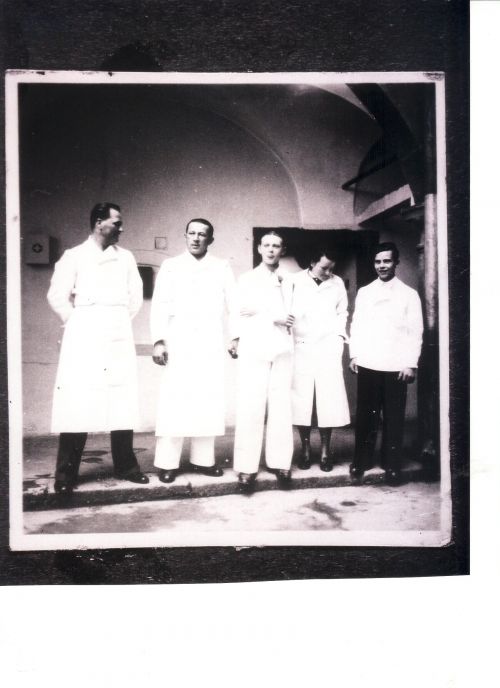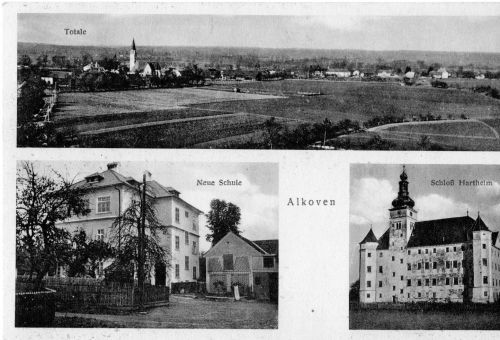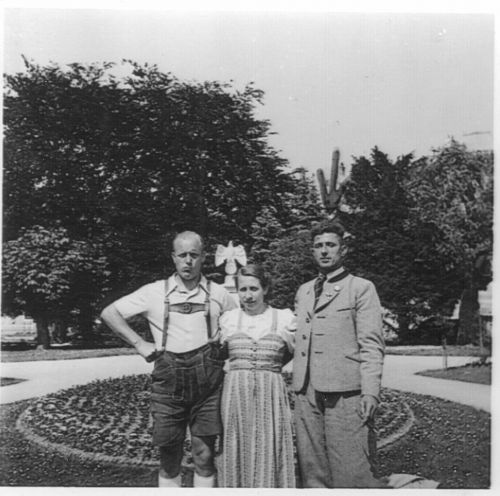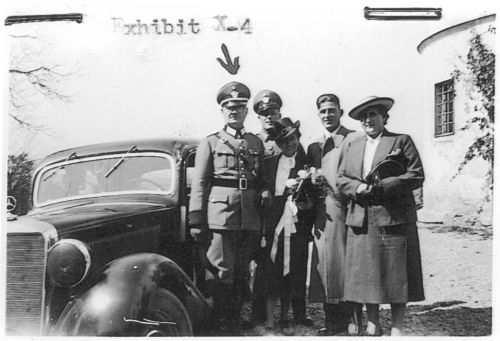Hartheim

Kurt Franz first left at Hartheim
Hartheim Schlos (Castle) situated in the village of Alkoven, near Linz, Austria, and close to the Mauthausen Concentration Camp, originally dated from the 9th Century. The Hartheim Castle, which can be seen today, was built at the end of the 16th Century, and by 1793, the building belonged to the princes of Starhemberg.

Alkoven - Pre-war postcard showing Schloss Hartheim (Chris Webb Private Archive)
In 1898, Hartheim Castle was donated to the Landes Wohltatigkeitssverein in Oberosterrich (Benevolent Society in Upper Austria), for the establishment of a home for physically and mentally handicapped children. After the Nazi annexation of Austria in March 1938, the Castle was converted into a euthanasia institute under the control of the T4 organisation, which was part of the Fuhrer's Chancellery. A gas chamber 5.8 meters long and 3.8 meters wide and 2.7 meters at its highest was constructed along with two crematoriums. One of the crematoriums was located in a room on the east side of the internal courtyard, and one was located in the courtyard itself. Offices and staff quarters were located on the upper floors of the Castle, while the killing installation occupied the ground floor, which surrounded the inner courtyard. The gas chamber located on the east side of the courtyard was disguised as a shower room and could hold a maximum of 150 persons. Senior stoker Josef (Sepp) Vallaster, who was later killed in the prisoner revolt in the Sobibor death camp in Poland, often administered the gas, without a physician being present.

Sepp Vallaster on the right at his wedding
At the western side of the Castle a wooden annex was built for the reception of the intended victims, constructed so that their arrival remained unseen by others. During May 1940, the first 633 patients were gassed. Four drivers operated the large grey busses of the Gekrat organisation which brought the victims to Hartheim Castle. After they had been gassed, any gold teeth were extracted from the corpses. If following cremation, any bones that were still visible among the ashes, then these were pulverised into dust using a bone mill. At least once a week a lorry left Hartheim Castle and drove to the Donau River and the Traun River to scatter the ashes into the water.
The Austrian Vinzenz Nohel was assigned to work as a stoker (Brenner) at Hartheim Castle receiving wages of 170 RM per month, plus a 50 RM stokers allowance and a 35 RM for his silence on what was taking place at Hartheim.Vinzenz Nohel recalled that, ' Furthermore because the work of a stoker was very strenuous and nerve shattering, we also received a quarter of a litre of schnapps every day.'
The first prisoners selected from Dachau Concentration Camp, some of whom had registered voluntarily for transfer to a 'convalescent camp' or 'sanatorium' arrived at Hartheim Castle, no later than January 1942. When the personal effects of those transferred were returned to Dachau with the address of the sender marked as 'Hartheim,' the voluntary registrations ceased. Prisoners were also transferred to Hartheim from other concentration camps, such as, Gross-Rosen, Ravensbruck, and Sachsenhausen. All the prisoners shared a common fate. After late August 1941, when Hitler ordered a cessation to the T4-euthanasia programme killing physically handicapped and mentally ill by gas, only concentration camp prisoners were gassed in the T4 killing institutes.
A number of personnel who were transferred to the Aktion Reinhardt mass murder programme of Polish Jewry served in Hartheim. The future commandant of the Sobibor and Treblinka death camps in Poland, Franz Paul Stangl recalled his T4 introduction and his arrival at Hartheim, in conversation with Gitta Sereny, for her book 'Into That Darkness.' and is of great importance in the history of Hartheim, and the wider history of the 'Final Solution.':
' I reported to Tiergartensrasse 4, I think to SS-Oberfuhrer Brack who explained what my specific police duties would be..... he said that to be effective in my new job, I had to be superior in rank to the local police chief of the nearest police authority, Alkoven - it was a man called Hartmann - and I would therefore be transferred to the uniformed branch with the rank of lieutenant.
He gave me the name of a village not too far from Linz, and a telephone number; I remember it was Alkoven 913.... I was to go to an inn on the outskirts of Linz -the Gausthaus Drei Kronen. It was on the Landstrasse- and phone that number. Stangl continued:
I went to the Drei Kronen and called Alkoven 913. A man answered, I told him my name, and he said, 'I'll come and get you.' About an hour later a kind of delivery van drove up - the driver was in civvies, a grey suit. When I asked him where we were going, he just said, 'In the direction of Everding.' And after an hour we got to Schloss Hartheim.
Gitta Sereny asked Franz Stangl how did it look? Stangl replied:
'Oh it was big you know, with a courtyard and archways and all that. It hadn't been a private residence for some time: they'd had an orphanage in it I think, and later a hospital. Almost the first person I saw - it was such a relief - was a friend: a colleague from the police, Franz Reichleitner. Franz Reichleitner had been told of his arrival . He had arranged for us to share a room. He'd show me around later, but first he had to take me to meet the doctors in charge and Hauptmann Wirth.'
Christian Wirth later served as commandant of the Belzec death camp, and later as Inspector of the SS Sonderkommando's Aktion Reinhardt in Poland, and worked with Stangl when he was commandant of Sobibor and Treblinka death camps. Stangl regarded Wirth as his bęte-noir:
'Wirth was a gross and florid man, my heart sank when I met him. He stayed at Hartheim for several days that time, and came back often. Whenever, he was there, he addressed us daily at lunch. And here it was again, this awful verbal crudity: when he spoke about the necessity for this euthanasia operation, he wasn't speaking in humane or scientific terms, the way Dr. Werner had described it to me. He laughed. He spoke of 'doing away with useless mouths' and said that, 'sentimental slobber' about such people made him puke.'

Wirth, Reichleitner, Vallaster at Sepp Vallaster's wedding
During the summer of 1943, Hartheim Castle became an administrative department of Aktion T4, since Berlin was being raided by Allied bombers, and it was no longer considered safe. Another administrative department was installed at the Aktion T4 recreation facility 'Haus Schoberstein' in Weissenbach at Lake Attersee, in Austria.
The population in the vicinity of Hartheim Castle soon became aware of the killings, after the arrival of one of the grey buses, a dark cloud always appeared over the castle. On days when there was a low cloud base, smoke would spread over the town, smelling of burnt flesh and hair, which caused some of the townsfolk to be physically sick. The fact that many people were brought to the castle, but nobody left, resulted in rumours being spread. To re-assure the citizens the Hartheim authorities arranged communal meetings. The townsfolk were told that the vile odours had been caused by the use of contaminated oil. A warning was issued against anyone speculating to the contrary.
The last 14f13 gassing at Hartheim occurred on 11 December 1944, and shortly afterwards during the same month and into January 1945, inmates of the Mauthausen Concentration Camp dismantled and removed the gassing installations. Although most of the T4 documentation was destroyed towards the end of the Second World War, a United States War Crimes Investigating Team discovered a box in Hartheim containing statistical reports on the number of people killed, which have formed the basis of modern-day attempts to establish the number of T4 victims.
In 1954, the rooms of the castle were temporarily converted into apartments for rent, and in 1969, a memorial was installed in the part of the castle used for killing people. The 'Verein Schloss Hartheim' was founded in 1995, with the objective of perpetuating the history of the NS- euthanasia at Hartheim, and they established an appropriate museum at the Castle in 2001.
Although it is impossible to establish a definitive figure for the number of victims, it has been estimated that by August 1941, the death toll at Hartheim had risen to at least 18,296; later during the Sonderbehandlung 14f13 operation, a further minimum of 12,000 further people were murdered. Among this figure were more than 8,000 inmates from concentration camps, such as Dachau, and Mauthausen, and its sub-camp at Gusen. These inmates included Russian Prisoners of War, Hungarian Jews, Jehovah's Witnesses, and other prisoners deemed unfit for work.
Sources
Sereny, Gitta, Into the Darkness, Pimlico, London, 1974.
Friedlander, Henry. The Origins of Nazi Genocide: From Euthanasia to the Final Solution, University of North Carolina Press, Chapel Hill, 1995.
Kogon, Eugen; Langbein, Hermann; Rückerl, Adalbert; eds. Nazi Mass Murder, Yale University Press, New Haven and London, 1993
Lifton, Robert Jay. The Nazi Doctors – Medical Killing and the Psychology of Genocide, Papermac, London, 1990.
http://www.schloss-hartheim.at
www. Holocaustresearchproject.org - online resource
Photographs: Chris Webb Archive, Kurt Franz Album, NARA
© Holocaust Historical Society 2020

